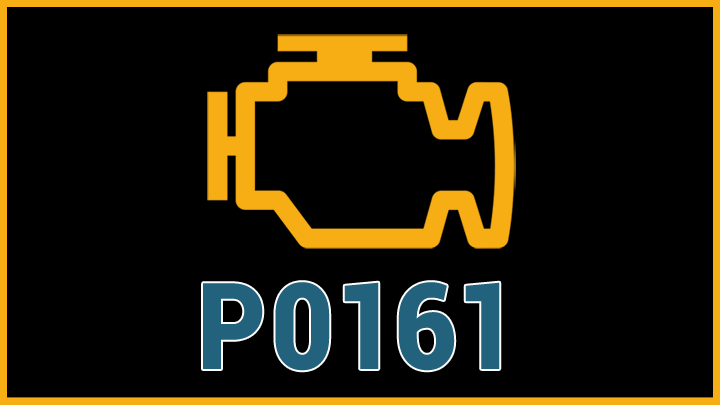
P0161 Oxygen Sensor Heater Circuit Malfunction (Sensor 2, Bank 2)
Content
P0161 – OBD-II Trouble Code Technical Description
Trouble code P0161 indicates a malfunction in the oxygen sensor heater circuit (sensor 2, bank 2).
What does the fault code mean P0161?
Trouble code P0161 indicates that the control engine module (PCM) has detected a problem in the second oxygen sensor (bank 2) heater circuit. This means that the heating element of this sensor takes longer to heat up than usual. The appearance of this error can lead to an increase in emissions of harmful substances in the vehicle's exhaust gases.

Possible reasons
Possible causes of DTC P0161:
- Oxygen sensor heater malfunction: The sensor heating element itself may be damaged or failed, resulting in insufficient or no heat.
- Wiring and Connectors: The wiring or connectors connecting the oxygen sensor heating element to the engine control module (PCM) may be damaged, corroded, or broken, preventing electrical signal transmission.
- Problems with the engine control module (PCM): Faults in the engine control module itself, such as damage or software errors, can lead to P0161.
- Poor connection or ground: Insufficient ground or poor connection between the oxygen sensor heater and the vehicle body can lead to heating problems.
- Problems with the catalyst: Faults in the catalytic converter, such as clogged or damaged, can cause P0161.
- Operating conditions: Extreme ambient temperatures or humidity may affect the operation of the oxygen sensor heater.
To accurately identify the cause of the error, it is recommended to have it diagnosed by a qualified auto mechanic.
What are the symptoms of a fault code? P0161?
Symptoms for DTC P0161 may include the following:
- The “Check Engine” light comes on.: This is one of the most common signs of a problem with the oxygen sensor or other engine management systems. When the PCM detects a malfunction in the oxygen sensor heater circuit, it may illuminate the check engine light.
- Loss of productivity: Insufficient heating of the oxygen sensor can lead to insufficient engine performance, which may manifest itself in loss of power, unstable engine operation or poor acceleration dynamics.
- Increased emissions of harmful substances: Incorrect operation of the oxygen sensor may result in improper fuel/air mixture adjustment, which may result in increased exhaust emissions, which may result in poor inspection results or violations of environmental standards.
- Poor fuel economy: A malfunctioning oxygen sensor can result in poor fuel economy due to improper fuel mixture control.
- Unstable idle: Improper fuel/air mixture management can also result in rough idle or even idle failure.
If you experience these symptoms and your check engine light comes on, it is recommended that you take it to a qualified auto mechanic for diagnosis and repair.
How to diagnose a fault code P0161?
To diagnose DTC P0161, which indicates a problem in the Bank 2 Oxygen Sensor heater circuit, you can perform the following steps:
- Checking the error code: Use an OBD-II scanner to read the P0161 trouble code and check if it is stored in the engine control module (PCM).
- Visual inspection of wiring and connectors: Inspect the wiring and connectors connecting the oxygen sensor heating element to the PCM. Check for damage, corrosion or broken wires.
- Checking the oxygen sensor heater: Using a multimeter, check the resistance of the oxygen sensor heater. Typically, at room temperature, the resistance should be around 6-10 ohms. If the resistance is too high or too low, this may indicate a problem with the heater.
- Checking grounding and power: Check if the oxygen sensor heater is receiving sufficient power and ground. Missing or insufficient power/grounding may cause the heater to not operate properly.
- Check the catalyst: Check the condition of the catalytic converter, as a faulty catalytic converter can also cause P0161.
- Checking the Engine Control Module (PCM): Diagnose the PCM for other errors or malfunctions that may affect oxygen sensor performance.
- Real-time testing: Perform a real-time oxygen sensor heater test using a diagnostic scanner to ensure the heater responds correctly to PCM commands.
If you are unsure of your skills or do not have the necessary equipment, it is best to contact a qualified auto mechanic for diagnosis and repair.
Diagnostic errors
When diagnosing DTC P0161, the following errors may occur:
- Incorrect diagnosis of the cause: One of the main mistakes can be incorrect identification of the cause of the error. For example, if you don't consider the condition of the wiring or other engine management system components, you may miss the root cause of the problem.
- Incorrect component replacement: Some mechanics may jump right into replacing the oxygen sensor heater without doing a full diagnostic. This may result in the replacement of a functional component, resulting in unnecessary costs.
- Ignoring other potential problems: Trouble code P0161 can be the result of several factors, including wiring faults, grounding problems, improper operation of the engine control module, and others. Ignoring these other problems may result in ineffective repairs and the error reoccurring.
- Incorrect interpretation of scanner data: Sometimes scanner data readings can be misinterpreted, which can lead to incorrect conclusions about the cause of the problem.
- Faulty sensors or instruments: Using faulty sensors or diagnostic tools may also lead to erroneous results.
To successfully diagnose the P0161 error code, it is recommended to use all available tools and carefully analyze every aspect of the problem before proceeding with repairs. If you are unsure of your skills or experience, it is best to consult a qualified professional.
How serious is the fault code? P0161?
Trouble code P0161 is not critical in terms of driving safety, but it is important in terms of engine performance and environmental aspects.
Failure of the oxygen sensor to warm up may result in engine management system malfunction and increased exhaust emissions. This may affect fuel economy, engine performance, and the vehicle's compliance with environmental standards.
Although this error is not an emergency, it is recommended that you take corrective action as soon as possible to avoid further engine problems and a decrease in the vehicle's environmental performance.
What repair will help eliminate the code? P0161?
Trouble code P0161 typically requires the following steps to resolve:
- Checking and replacing the oxygen sensor heater: If the oxygen sensor heating element does not function properly, it must be replaced. This may require removing and replacing the oxygen sensor.
- Checking and replacing wiring and connectors: The wiring and connectors connecting the oxygen sensor heating element to the engine control module should be carefully inspected for damage, corrosion, or breaks. If necessary, they should be replaced.
- Checking and replacing the engine control module (PCM): If other causes of the malfunction are excluded, it is necessary to diagnose the engine control module. If problems are found with the PCM, it may require repair or replacement.
- Check the catalyst: Sometimes problems with the catalytic converter can cause the P0161 code. Check the condition of the catalyst and replace it if it is damaged or clogged.
- Thorough system testing: After repair work, you must thoroughly test the system using an OBD-II scanner to ensure that error P0161 no longer occurs and all oxygen sensor parameters are normal.
Depending on the cause of the P0161 code and the characteristics of your specific vehicle, repairs may require different steps. If you do not have the experience or skills to perform these jobs, it is recommended that you contact a professional auto mechanic.
P0161 – Brand-specific information
Several interpretations of the P0161 fault code for various car brands:
- Toyota, Lexus, Scion: “Heat oxygen sensor 2, bank 2 – circuit malfunction.”
- Honda Acura: “Oxygen sensor heater circuit malfunction (Bank 2 Sensor 2).”
- Ford, Lincoln, Mercury: “Oxygen sensor (O2) – heating, Bank 2 – insufficient heating.”
- Chevrolet, GMC, Cadillac: “Heating oxygen sensor 2, bank 2 – low voltage.”
- BMW, Mini: “Heating oxygen sensor 2, bank 2 – low voltage.”
The decoding may vary slightly depending on the specific model and year of manufacture of the car. If you have a specific make and model you would like to know, I can provide more specific information.
